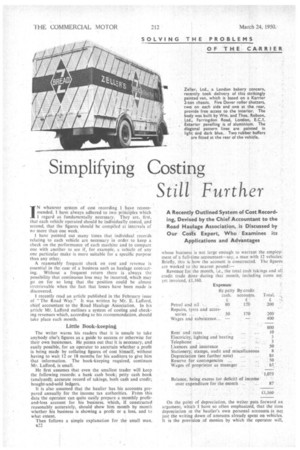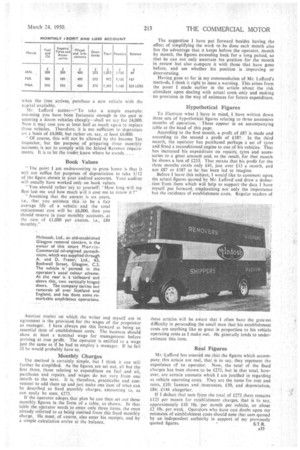Simplifying Costing
Page 56

Page 59

If you've noticed an error in this article please click here to report it so we can fix it.
Still Further IN whatever system of cost recording 1 have recommended, I have always adhered to two principles which I regard as fundamentally necessary. They are, first, that each vehicle operated should be individually costed, and second, that the figures should be compiled at intervals of
no more than one week.
I have pointed out many times that individual records relating to each vehicle are necessary in order to keep a check on the performance of each machine and to compare one with another to see if, for example, a vehicle of any one particular make is more suitable for a specific purpose than any other.
A reasonably frequent check on cost and revenue is essential in the case of a business such as haulage contracting. Without a frequent return there is always the possibility that continuous loss may be incurred, which may go on for so long that the position could be almost irretrievable when the fact that losses have been made is discovered.
I recently read an article published in the February issue of "The Road Way." It was written by Mr. E. Lafford, chief accountant to the Road Haulage Association. In his article Mr. Lafford outlines a system of costing and checking revenues which, according to his recommendation, should take place each month.
Little Book-keeping The writer warns his readers that it is unsafe to take anybody else's figures as a guide -to success or otherwise for their own businesses. He points out that it is necessary, and easily possible, for an operator to ascertain whether a profit is being made by collating figures of cost himself, without having to wait 12 or 18 months for his auditors to give him that information. The book-keeping required, continues Mr. Lafford, is small.
He first assumes that even the smallest trader will keep the following records: a bank cash book; petty cash book (analyzed); accurate record of takings, both cash and credit; bought-and-sold ledgers.
It is also assumed that the haulier has his accounts prepared annually for the income tax authorities. FrOm this data•the operator can quite easily prepare a monthly profitand-loss account for his business, which, if constructed reasonably accurately, should show him month by month whether his business is showing a profit or a loss, and to what extent.
Then follows a simple explanation for the small man, B22 when the time arrives, purchase a new vehicle • with the capital available.
Mr. Lafford states:—" To take a simple example; assuming you have been fortunate enough in the past in securing a dozen vehicles cheaply—shall we say for £4,000. Now it may cost you at least half as much again to replace those vehicles. Therefore, it is not sufficient to depreciate on a basis of £4,000, but rather on. say, at least £6,000.
"Of course, this will not be allowed by the Income Tax inspector, but the purpose of preparing these monthly accounts, is not to comply with the Inland Revenue requirements. It is to let the trader know where he stands....
Book Values
I he point I am endeavouring to press home is that it will not suffice for purposes of depreciation to take 1/12 of the figure shOwn in your audited accounts. Your auditor will usually have worked only on book values.
" You should rather-say to yourself: How long will my
fleet last me. and how much it cost me to renew it ?"
Assuming that the answer is six years, i.e., that you estimate this to be a fair average life of a vehicle and the total replacement cost will be £6,000, then you should reserve in your monthly accounts, at the rate of £1,000 per annum. i.e., £84 monthly."
Another matter on which the writer and myself are in agreement is the provision for the wages of the proprietor as manager. I have always put this forward as being an essential item of establishment costs. The business should show at least a nominal wage for management before arriving at true profit. The operator is entitled to a wage just the same as if he had to employ a manager. If he fell ill he would probably have to.
Monthly Charges The method is certainly simple, but I think it can still further be simplified. As the figures are set out, all but the first three, those relating to expenditure on fuel and oil, purchases and repairs, and wages do not vary from one month to the next. It is, therefore, practicable and convenient to add them up and just make one item of what can be described as fixed monthly charges, amounting to, as can easily be seen, £273.
If the operator adopts that plan he can then set out these monthly figures in the form of a table, as shown. In that table the operator needs to enter only, three items, the ones already referred to as being omitted from this fixed monthly charge. He must, of course, also enter his receipts, and by a simple calculation arrive at the balance.
The suggestion 1 have put forward • besides having the effect of simplifying the work to be done each month also has the advantage that it keeps before the operator, month by month, the figures extending back, for a tong period,so that he can not only ascertain his position for the month in review-, but also compare it with those that have gone before, and see whether his position is .improving or deteriorating.
Having gone so far in my commendation of Mr. Lafford's methods, I think it right to issue a warning. This arises from the point I made earlier in the article about. the risk attendant upon dealing with actual costs only and making no provision in the way of estimates for future expenditure.
Hypothetical Figures
. To illustrate what I have in mind, I have written down three sets of hypothetical figures relating to three successive months of operation. These appear in an accompanying table at the head of this page. .
According to the first month, a profit of £87 is made and according to the second a profit of £187. In the third month, the operator has purchased perhaps a set of tyres and.fitted a reconditioned engine to one of his vehicles. That has increased his expenditure on repairs, tyres and accessories to a great amount and, as the result, for that Month he shows a loss of £231 That means that his profit for the three months totals only £41, just over £13 a month, and not £87 or £187 as he has been led to imagine.
Before I leave this subject, 1 would like to comment upon the actual figures quoted by Mr. Lafford and draw a deduction from them which will help to supPort-the data 1 have myself Put forward, emphasizing not 'only. the importance hut the incidence of establishment costs. Rekutar readers of
these articles will be aware that 1 often have the greatest difficulty in persuading the small. man that his establishment costs are anything like so great in proportion to his vehicle operating costs as I make out. He generally tends to underestimate this item.
Real Figures
Mr.-Lafford has assured me that. the figures which accompany,this article are real, that is to say, they represent the experience of an operator. Now, the total of the fixed charges has been shown to be £273, but in that total, however, are certain amounts which I am justified in regarding as vehicle operating costs. . They are the items for rent and rates, £10; licences and insurances, £50, and depreciation, £84; £144 altogether.
If I deduct that sum from the total of £273 there remains £125 per month for establishment charges, that is to say, approximately £10 10a. per month per vehicle, or about £2 10s. per week. Operators who have cast doubt upon my estimates of establishment costs should note that sum quoted by an independent authority in support of my previously
quoted figures. S.T.R.




























































































